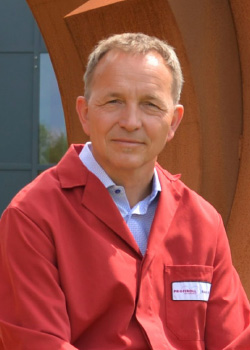How Does the Way to Standardized Production of Fuel Cell and Electrolyzer Components Look Like?
Get the Roadmap for the Future of the Hydrogen Market
Together with experts from industry and research, Graebener® presents a comprehensive white paper that provides specific, practice-oriented recommendations for the various process steps involved in the standardized production of bipolar plates.
The publication provides answers to the questions that are of concern to the market and potential customers when planning production projects. The process navigator provides a condensed overview on just two pages and makes a specific recommendation on what needs to be considered in the eight process steps that build upon one another (material selection, forming, cutting, welding, straightening, leak testing, coating, seal application).
Your Exclusive Preview of Selected Contents of the White Paper
Experts from Business and Research Who Have Their Say in the White Paper

"Because we have so many filigree structures in the bipolar plate, every influence from a material perspective obviously has to be taken into account. Grain size, thickness tolerance, roughness – it all plays a role."
Tobias Heinz,
Sales
CellForm Hydrogen

"As a product, the bipolar plate looks pretty trivial to many who are not familiar with it. If you try it, you quickly notice that the forming just isn't standardeven if the product looks trivial."
Simon Brugger,
Co-Founder & CEO
CellForm Hydrogen

"It is a huge advantage to be able to access the relevant equipment to produce prototypes and small series. This saves valuable time and costs which can be a critical advantage in new project acquisition."
Dr. Dominik Kraus,
Head of Stamping Technology
Freudenberg Sealing Technologies

"The seal issue has so far not been properly addressed."
Jürgen Emig,
Director Pre-Product Development Hydrogen Applications
Freudenberg Sealing Technologies

"Dispensing technology today has many advantages over other methods, but must continue to evolve."
Janik Hermann,
Product Manager Dispensing Systems
Datron

"If you are looking to operate the machines properly, over a long period of time, especially with large quantities, then cleanliness and cleaning of the system, and especially of the plates, is a very big issue."
Daniel Schönbohm,
Sales
Worthmann Maschinenbau/MACEAS

"If we were to come away from metal nitrides combined with precious metals and look more toward diamond-like carbon, and if we could also still achieve the same durability, then the costs would be halved at a stroke."
Dr. Ing. Herbert M. Gabriel,
Managing Director
PVT Plasma und Vakuum Technik

"This shows that producing bipolar plates is not straightforward."
Dr.-Ing. Jörg Karstedt,
Head of the Department Fuel Cells and Stacks
Zentrum für BrennstoffzellenTechnik

"Quality and safety come first. This does not mean that we will never talk about price, but we are not in a mass market. For aviation, I don't see the possibility of offering the highest quality with minimum costs. Not yet."
Patrick Raynal,
Project Manager
Safran

"I can't replace one production technology with another and, in doing so, maintain the same underlying parameters for the constructive design."
Dr. Stephan Kohlsmann,
Managing Director
Profiroll Technologies
 "Currently, we are now aiming for a hundred plates per minute. We are therefore still some way away from the ten-hertz technology. Although that's really only part of the story; it always depends on the plate size, the thickness of the metal and the film. Ten-hertz technology is more of a buzzword for policymakers."
"Currently, we are now aiming for a hundred plates per minute. We are therefore still some way away from the ten-hertz technology. Although that's really only part of the story; it always depends on the plate size, the thickness of the metal and the film. Ten-hertz technology is more of a buzzword for policymakers."
Dr. Michael Hirsch,
Engineer
Profiroll Technologies

"In a flow process in which all processes are arranged in a web, the slowest process obviously determines the web speed."
Werner Volk,
Business Development Manager
OPTIMA packaging group

"At some point, for bipolar plates and fuel cell stacks, there will certainly also be standards for individual parts and components. But not for the overall system or the individual design of the bipolar plate."
Fabian Kapp,
Managing Director
Graebener®
Key Questions Answered from Different Perspectives in the White Paper
Perspective on mechanical engineering and medium-sized companies
- What are the decisive factors for the successful production of metallic bipolar plates?
- What obstacles need to be overcome and what potential pitfalls need to be avoided?
- What is the current state of affairs and where do we need to be in the future if components are to be mass-produced?
The publication also highlights various technology alternatives that are available to potential customers for their production lines. In addition, the factors in the upstream and downstream process steps that play a crucial role in the overall success are also in focus.
The perspective of research and development
- What interactions exist between application, quality and cycle time?
- What factors influence the issues of safety and service life?
- How can the current status of line production be evaluated and what needs to happen for production technologies to be ready for the market in the next few years?
Potential customers: Perspective sales market
When looking at the market, the question of what will be needed in the future in order to make well-founded decisions arises.
- How much standardization versus flexibility will be necessary in order to effectively dovetail the individual process steps?
- How can the demands for quality and high cycle times be met?
